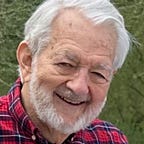Dick Steinheimer, Product photographer, Artisan
A profile from Tom Mahon’s book about Silicon Valley, Charged Bodies
Dick Steinheimer, “Stein” as he refers to himself, shares a small office space near the Bayshore Freeway now. His aren’t the habits of today’s fashionable leather-jacket-and-jeans artisan. Rather, he looks as if he’d be more at home in a small town in the Southwest, sporting some silver and turquoise jewelry, selling his photos of desert sunrises.
Stein’s profession is high-tech photographer. One of the first to photograph microelectronic devices for sales brochures. In time such work will be considered high-art and appear in museums and art galleries.
Stein has another life he didn’t mention in our meeting. I discovered later that he was also a pioneer in railroad photography and documented American railroad’s transition from steam locomotives to diesel during the second half of the 20th Century. He has been called the “Ansel Adams of railroad photography”
But his work with chips isn’t in magazines or books, it’s in slim marketing brochures and sales pieces he keeps filed away.
Yet in spite of the overtly commercial context of the work, Stein and the other photographers of early microelectronic devices were creating a new genre that would later become recognized as a legitimate art form when others created similar works for the covers of Scientific American, Omni and High Technology.
When he was hired by Fairchild in the early ‘60s, it was the beginning of a new world for him. “Here we had a field with all kinds of subjects, of people, of processes, of products. . . with very few pictures ever taken of them. For a person like myself, who liked to experiment, liked to take things and try to deduce some of their meanings by photographing them . . . wow! It was fantastic!”
“Bob Noyce, the general manager there, was a delight. Approachable, not always talkative. Once, there was a very serious meeting with customers, and during the meeting Bob’s secretary came in and handed him a little written message. Just real smoothly, he got up and said, ‘Well, gentlemen, I think I’m going to have to go now, but I’m sure that you can conclude the meeting.’”
The salesman was awfully curious, because he had seen Bob throw the wadded note in the trash basket. So he went over and opened it and it said, ‘Your wife just called and wants you to come home immediately. The burro has gotten out again.’ “
There were so many unassuming men of extraordinary accomplishment then, according to Stein. Like a quiet engineer who went modestly about his work in a back lab Fairchild. “All the guy ever did was lay the groundwork for today’s digital voltmeter. Well, wow! That’s like inventing bread. These inventions were coming up around us like that all the time.”
Photos, copyrights owned by respective copyright holders
